
According to 2021 data from Spate, microneedling posted an 83.3K increase in monthly search volume, representing 33.2% year-over-year growth. The rise was attributed to pent up demand among consumers who locked down in 2020, as well as increased time spent researching so-called “tweakments.” Here, author Nancy Trent digs into the microneedling trend drivers. -Editor
Microneedling (MN) is a popular, minimally invasive procedure, with origins dating back to the early 20th century, where surgeons in Europe utilized a primitive version of the technology to treat scarring of the skin. However, these early practices have been superseded by the modern-day approach to MN (for treating scars as well as anti-aging purposes), utilizing dermal rollers and mechanical pens, which found their place in the industry in the mid 1990s and early 2000s, respectively. Now, they are safe enough to use at home.
Daniel Clary, VP of AnteAGE Education, explains, “The general concept behind microneedling is the utilization of surgical needles, penetrating the skin at varying depths, in order to trigger a wound healing cascade. This mechanical wounding not only breaks up fibrotic (scar) tissue, but also triggers the skin to produce new structural protein such as collagen. At a molecular level, this controlled injury causes the skin cells to release cytokines and growth factors, biological signaling proteins that are responsible for the coordination of the healing cascade initiated by the needles. The channels created by needles also create an opportunity to penetrate certain ingredients into the skin, though providers need to be highly selective as to which ingredients they use in order to avoid an unwanted inflammatory immune response.”
Providers (and patients) have embraced the practice of microneedling for a variety of reasons. MN, in its purest form, is solely a mechanical procedure that avoids the controlled thermal (heat) energy and chemical (acid) burn associated with other advanced skin modalities. This not only makes the procedure safe for all skin types, it also dramatically cuts the typical downtime seen with lasers and peels.
Clary adds, “Depending on the protocol administered, patients will leave the treatment room with mild to moderate erythema (redness) that usually resolves itself within 24-48 hours.”
In addition, MN has proven to be a highly efficacious modality in the aesthetic world, with myriad clinical benefits including the reduction of scar tissue, increased collagen that leads to reduced lines and wrinkles, softening of textural irregularities, as well as the ability to treat hyperpigmentation and even acne.
The use of microneedling tools at home, when performed correctly and, ideally, under the guidance of a professional, provides the skin with significant benefits.
In fact, one 2017 study from Clinical, Cosmetic and Investigational Dermatology notes, “[MN] has shown promising results as an adjuvant therapy for enhanced drug delivery in the treatment of atrophic scars, alopecia, actinic keratoses and disorders of pigmentation such as melasma … Overall, the procedure has few adverse sequelae compared to other therapies, is highly efficacious, and is a viable resurfacing option for skin of color.”
“It is important to make the distinction that these home tools should only contain needles of a shallow depth (usually around 0.25 mm), often referred to as cosmetic needling, and that they do not replace clinical needling, at deeper depths, performed by the aesthetic provider in the clinic,” Clary said.
That being said, there is great synergy between these two modalities and patient clinical outcomes can be dramatically enhanced when combined. Monthly clinical needling sessions are excellent to treat more significant signs of aging such as deep lines and wrinkles, as well as scar tissue. While home cosmetic needling doesn’t work as well for these indications, shallow depths have benefits.
In fact, clinical evidence in the literature shows that when shallow depth needling is performed (home usage recommendation is one to three times weekly, ideally), there is an increase in gene expression for proteins that both strengthen the skin's barrier, as well as that of the dermal-epidermal junction (DEJ), identified as one of the most important regions of the skin for maintaining structural integrity. One can think of the at-home shallow depth treatments as your weekly workouts, while the monthly clinical sessions are your more intense boot camp for the skin.1
Clary said, “This is fitness for your skin. Home needling is a great place to start for patients who are not quite ready to dive into clinical needling, or as an excellent way to prepare the skin and condition/prime it for upcoming clinical needling sessions. Again, proper usage, sanitation and careful selectivity of topical adjuvants is paramount to the success of home needling.”
Clary continued, “It is very important that one chooses a reliable and trusted source for their home needling tools, as many options out there can indeed be of inferior quality. However, when the right tool is chosen and used correctly, the safety profile of home needling is quite high. Many myths and misconceptions are out there when it comes to home needling, especially the usage of dermal rollers. By far, the biggest myth is that they somehow tear the skin. This is far from the truth and has not been proven in any quality in-vivo model.”
Often, an animated image of the needles entering the skin is used as evidence that their angle of entry proves tearing potential. This is flawed in many ways. Keep in mind that needle depths recommended for home use are quite shallow, only penetrating to just below the stratum corneum.
The skin also maintains excellent flexibility and is not pulled taut from end-to-end like a carpet. As the chamber of the dermal roller passes over the skin, the skin is pushed upwards and the needle enters closer to 90 degrees. Given that the needles are circular, simple physics would make them an unlikely cutting tool.
Clary adds, “It is suggested that they can potentially scar the skin. It is important to remember that scarring only occurs in the dermis and these needles are only penetrating the upper stratum granulosum of the epidermis.”
With the right tool, the right guidance and usage protocol and the right topical adjuvant, home needling is a powerful tool that providers can offer their patients as a compliment to their clinical treatments, as well as their home skin care products.
Perhaps most importantly for many readers, it’s worth noting that MN treatments have spawned a wide range of at-home MN and aftercare products. Current offerings include the BeautyBio Get That Glow—GloPRO Facial Microneedling Discovery Set, FaceGym Hyaluronic Acid Roller Dissolving Microneedling Tool and Faceshot Electric Microneedling Device + Vitamin Ampoules, Peace Out Microneedling Anti-Wrinkle Retinol Patches and Microneedling Dark Spot Brightening Dots, Pacifica Wake Up Beautiful Microneedling Patches and Wake Up Beautiful Overnight Retinoid Cream, Skyn Iceland Dissolving Microneedle Eye Patches With Hyaluronic Acid and Peptides, and many others.
1“Upregulation of Genes at the Dermal-Epidermal Junction” – The Concise Guide to Dermal Needling, Third Medical Edition – Revised & Expanded, page 68-76. L. Setterfield, M.D. Acacia Dermacare










